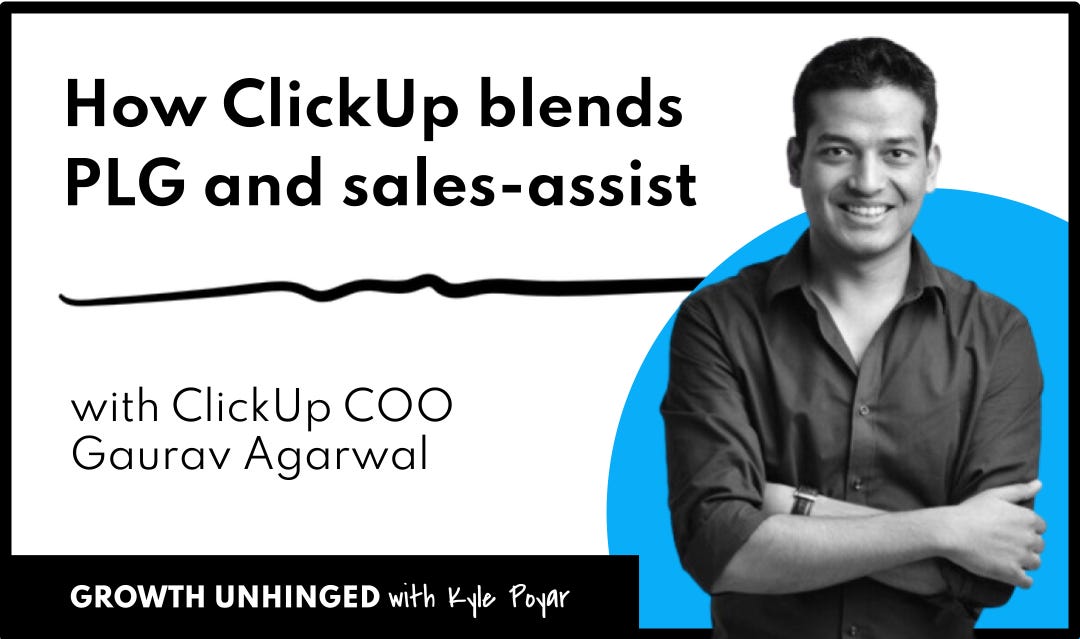How ClickUp blends PLG and sales-assist
COO Gaurav Agarwal on cutting CAC payback in half, the modern PLG org structure, and embracing incrementality over attribution
👋 Hi, it’s Kyle and I’m back with a new Growth Unhinged, my newsletter that explores the unexpected behind the fastest-growing startups. My new Icons series uncovers how top brands like Calendly and Miro build modern revenue machines. Up today: ClickUp.
You might recognize ClickUp for its Super Bowl ad, viral music album (over a million streams on Spotify), or path to crossing $100 million ARR in under five years. The business also happens to serve 10 million users (including 80% of the Fortune 500) and is #63 on the Forbes Cloud 100, a list of the best-performing private software companies.
I’ve long admired the all-in-one productivity platform as one of the rare software companies that has nailed a modern go-to-market (GTM) strategy combining both product-led and sales-assist. (I previously featured their innovative approach to pairing outbound and PLG.)
Gaurav Agarwal joined ClickUp as Chief Growth Officer in February 2022. He was recently promoted to COO as a result of a fantastic track record. Under Gaurav’s leadership ClickUp has:
Honed its PLGTM distribution model, combining the best of Growth, Product, Sales, CX, and Data
Cut CAC payback in half
Continued to beat its annual plan and deliver top decile YoY growth
Product-led go-to-market (PLGTM) is the future of SaaS (and AI) distribution and go-to-market strategy. The goal is to combine the best of digital and human touch, and in doing so deliver a seamless customer experience that efficiently unlocks revenue. Very few companies have got this motion right – and ClickUp is among those.
For all of these reasons, I’m thrilled to share an in-depth look at how ClickUp blends PLG and sales-assist. If you want to learn more, follow Gaurav on LinkedIn or check out ClickUp (they’re hiring!).
Revenue as the North Star, embracing incrementality over attribution
I entered into growth from the perspective that revenue needs to be treated like a repeatable machine. You need to be experimenting all the time on how to make that machine better, and you need to be uncovering new ground to find opportunities.
Revenue machines in B2B are changing very fast and are becoming more holistic than ever before. Especially in a PLG environment, there is no single revenue owner!
There are multiple revenue owners. And then there are rocky overlaps – or, if we can operationalize these overlaps, there are compounding overlaps. How do you create an org where there is some healthy overlap, but where the goals are very clear and there is autonomy and clear accountability? And how do you build a culture with a company-first mentality? People can’t be optimizing for their own revenue areas in a silo.
You need a strong base for data and incrementality. In the B2B marketing world, I hear a lot about the word attribution. I don’t hear the word incrementality.
The consumer world moved from attribution to incrementality a long time ago, companies like Netflix pioneered that. You need to understand the incrementality of everything that you do.
When I started at ClickUp as Chief Growth Officer, that was primarily growth product, acquisition, growth marketing, demand gen, and data. Now I am responsible for growth, acquisition, all of sales, post-sales, marketing, data, and systems. Across the teams, everyone has a KPI that directly ladders up to revenue – or where I can draw a causal inference against that. Sometimes causality could be a static number; sometimes it can be a little more anecdotal or a red, yellow, green indicator. But there has to be a strong relationship.
The five pillars of ClickUp’s PLGTM org
Keep reading with a 7-day free trial
Subscribe to Kyle Poyar’s Growth Unhinged to keep reading this post and get 7 days of free access to the full post archives.





